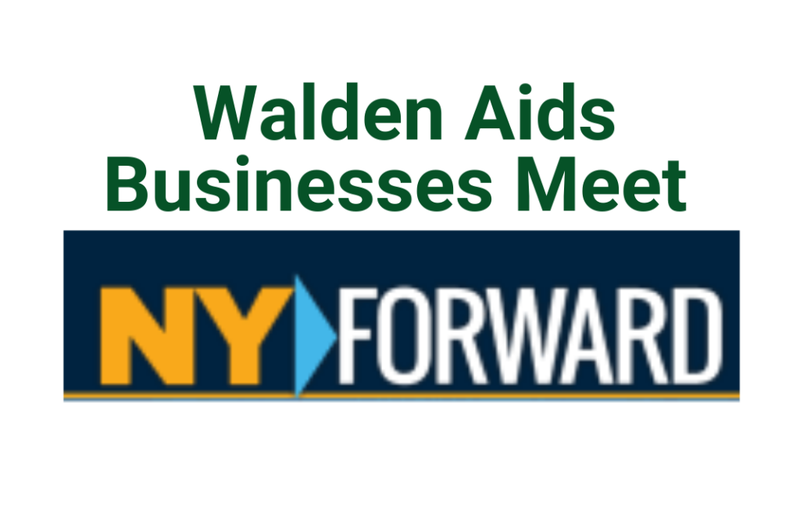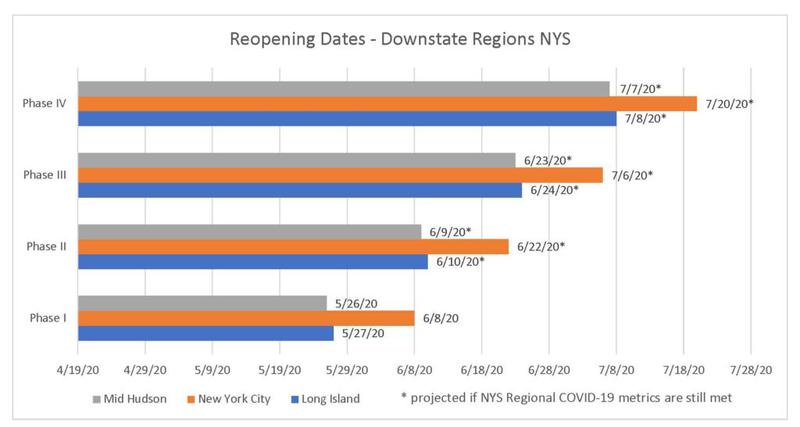
New York Forward, the State of New York’s plan for reopening business after the COVID shutdown has reached important thresholds this week, with Phase I businesses in New York City allowed to open on Monday, June 8, and Phase II businesses allowed to open on Long Island on Wednesday, June 10, as discussed below. The New York State Department of Health has issued guidelines for businesses to reopen, provided that they are implementing a COVID Safety Plan developed based on the generic templates published by the State, as summarized in Walden’s recent blog.
When considering how you will open your business, Walden offers five key things to consider:
1. Do My Operations Fall Under the Phase I or Phase II Reopening Guidelines?
- Phase I businesses (allowed to reopen on Long Island on May 27th and in New York City on June 8th) include: construction; manufacturing; wholesale trade; retail trade; and agriculture, forestry and fishing.
- Phase II businesses (proposed reopening on Long Island on June 10th and in New York City on June 22nd) include: office; real estate; essential in-store retail; vehicle sales; commercial building management; retail rental, repair and cleaning; and hair salons and barbershops.
Please note that under these guidelines, businesses are only allowed to bring back up to 50% of their work force, while other workers would continue to work from home. Businesses not complying with these requirements are subject to fines and potential shutdown.
Specific businesses and operations are prohibited from reopening during Phases I and II, such as indoor shopping malls, dine-in restaurants, gatherings larger than 10 people, gyms, casinos and video lottery establishments, movie theaters, and places of amusement (specifically noted pools and water attractions).

2. Should I Follow the Generic State Template or Prepare a Business/Location-Specific Safety Plan?
The key to answering this question is deciding what level of concern you’re willing to project to your stakeholders. The State’s generic template presents the minimum level of protection for your workers, customers and stakeholders. In order to demonstrate your commitment to protecting those involved in your business, you should consider including other items in a detailed site-specific COVID Safety Plan such as:
- How many workers do I bring back to my workplace, and at what frequency?
- If the State allows up to 50% of my staff back to the workplace, how do I determine how many to bring back, and how to alternate?
- Do I need specific procedures for practices such as business entry, cleaning, personnel separation, PPE supply and use?
- How do I integrate this Plan with my current site-specific OSHA Health and Safety Plan or any other OSHA applicable standards?
3. How Should I Modify My HVAC Equipment and Improve Ventilation in the Workplace?
- The main keys to protecting people from the spread of the COVID virus are social distancing and wearing a face covering. These actions serve to contain aerosol viral particles in the face covering and dilute the concentrations potentially transmitted. In work spaces with little air circulation or air replacement, aerosol viral particles linger; note that most common HVAC equipment recirculates indoor air. Some HVAC air handlers offer the option to allow up to 100% make-up air, replacing indoor air with fresh outside air and through exhausting indoor air. In other cases, the levels of outdoor air in the workplace can be increased by opening windows or doors and adding mechanical ventilation in the form of fans. Detailed evaluations of HVAC equipment, current system settings and options for modification by a professional can allow you to increase fresh air in your indoor workplace, and reduce the potential for COVID transmission.
4. What Level of Training Should I Provide to My Employees?
- Walden has found that employees are largely unaware of the mechanism of exposure to the virus, means available to protect themselves and others from virus, and changes in workplace operations to offer protection against exposure. Any site-specific COVID safety plan must include training in virus awareness (routes of exposure and signs and symptoms) and newly developed Standard Operating Procedures (travel within the workplace, cleaning expectations, and use and care of PPE). Training must always be followed by acknowledgement and record-keeping to document that the employees have been trained. Remember, if actions are not documented, in the opinion of OSHA and NYSDOH, it did not happen.
5. How Do I Demonstrate My Commitment to a Safe Workplace and Active COVID Protection?
- The more effort a business puts into preparing for safe reopening, the more confidence its employees will project to its customers and stakeholders. Confidence is key to the acceptance of your workplace as being a safe place to work. Many of the items addressed in this article, when implemented together, will grow your employees’ confidence about getting back to work safely. Posting signage on the entry to your business and strictly adhering to your COVID Plan will also demonstrate your commitment to the safety and well-being of your employees and customers.
At Walden, we stand ready to support our current clients and new business and municipalities to ensure safe business practices. Contact Walden’s team of environmental engineers and industrial hygiene professionals to help you plan and navigate the COVID reopening of your business in the safest and most cost-effective way.
